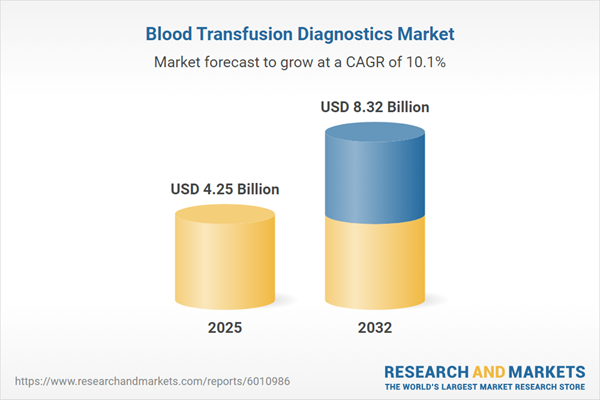Speak directly to the analyst to clarify any post sales queries you may have.
The Blood Transfusion Diagnostics Market is evolving as healthcare organizations seek solutions that strengthen patient safety and ensure operational consistency. With compliance requirements intensifying and diagnostic workflows becoming more complex, market participants are turning to innovative approaches and robust procurement strategies to support care delivery objectives.
Market Snapshot: Blood Transfusion Diagnostics Market Size & Growth
The Blood Transfusion Diagnostics Market is set for substantial expansion, moving from USD 3.86 billion in 2024 to USD 8.32 billion by 2032, reflecting a compound annual growth rate (CAGR) of 10.08%. This upward trajectory is propelled by the integration of advanced diagnostics, the broader implementation of molecular assays, and heightened attention from regulatory agencies. Laboratories are embracing automation and stringent compliance management, directly improving the quality and reliability of transfusion-related processes. These strategies allow health systems to respond to evolving clinical workflows with enhanced patient care and operational agility.
Scope & Segmentation
This strategic analysis is crafted for senior executives who require actionable insights for procurement optimization and diagnostics workflow refinement. Navigating the market’s segmentation landscape enables organizations to align resources effectively and make informed business decisions.
- Diagnostics Products: Microplates, pipette tips, reagents, instruments, testing kits, nucleic acid analyzers, and pathogen reduction devices play pivotal roles in standardizing laboratory operations and supporting accuracy.
- Technological Platforms: PCR and real-time PCR systems, pathogen reduction agents, as well as serological methods like CLIA, ELISA, and lateral flow assays, deliver comprehensive tools for blood screening and disease management.
- End Users: Hospital blood banks, independent laboratories, and research institutions each require tailored solutions that reflect unique procurement processes and compliance demands.
- Applications: Key applications span donor screening for infectious agents, validation of quality control measures, blood group typing, and procedures for pathogen inactivation, all of which underpin rigorous transfusion safety protocols.
- Regional Analysis: Comparative assessment across the Americas, Europe, Middle East & Africa, and Asia-Pacific emphasizes variations in operational and regulatory landscapes. Country-specific insights for the US, Canada, Brazil, Germany, China, and India help shape effective market entry and operational frameworks.
- Industry Leaders: Detailed company profiles include Ortho Clinical Diagnostics, Grifols, Thermo Fisher Scientific, Immucor, Bio-Rad Laboratories, Danaher Corporation, F. Hoffmann-La Roche, Abbott Laboratories, Siemens Healthineers, and bioMérieux, each setting benchmarks in technology integration and procurement excellence.
Key Takeaways for Senior Decision-Makers
- Molecular and serological innovations are reinforcing reliability in diagnostics, enabling clinical teams to develop pathways responsive to safety objectives and shifting patient needs.
- Digital data analytics is facilitating oversight across multiple laboratory sites, supporting consistent operational outcomes and dynamic logistical planning.
- Collaboration between technology suppliers and reagent partners is optimizing solution integration, helping organizations expand diagnostic capabilities and streamline procurement activities.
- Aligning procurement initiatives with specific end-user requirements is strengthening resilience to regulatory shifts and supporting robust supply chain continuity.
- Growth in regions such as Asia-Pacific is broadening diagnostic access, promoting harmonization of standards, and equipping organizations with operational flexibility for global expansion.
Tariff Impact and U.S. Market Resilience
Changing tariff structures for diagnostic instruments and consumables are shaping procurement strategies within the U.S. healthcare sector. Leadership teams are expanding supplier relationships, adjusting product categories, and leveraging contract manufacturing agreements to counter supply chain disruptions. These focused measures support reliable blood transfusion diagnostics operations even as trade policies evolve.
Methodology & Data Sources
This report is grounded in a multi-phase research design, utilizing peer-reviewed academic literature, regulatory filings, patent analysis, and expert interviews. The methodology aligns closely with the operational realities of procurement professionals and laboratory managers across the Blood Transfusion Diagnostics Market.
Why This Report Matters
- Arms senior leaders with data-driven guidance for procurement and management of diagnostic systems, creating pathways for better patient outcomes.
- Delivers clear, actionable recommendations for technology integration, ensuring organizations remain adaptive to regulatory requirements and market shifts.
- Offers segmentation analysis to support responsive, resilient strategies as the blood transfusion diagnostics landscape evolves.
Conclusion
This report equips executive decision-makers with focused market intelligence to optimize procurement, elevate laboratory workflows, and reinforce adaptability within healthcare organizations.
Additional Product Information:
- Purchase of this report includes 1 year online access with quarterly updates.
- This report can be updated on request. Please contact our Customer Experience team using the Ask a Question widget on our website.
Table of Contents
3. Executive Summary
4. Market Overview
7. Cumulative Impact of Artificial Intelligence 2025
Companies Mentioned
The companies profiled in this Blood Transfusion Diagnostics market report include:- Ortho Clinical Diagnostics, Inc.
- Grifols, S.A.
- Thermo Fisher Scientific Inc.
- Immucor, Inc.
- Bio-Rad Laboratories, Inc.
- Danaher Corporation
- F. Hoffmann-La Roche Ltd
- Abbott Laboratories
- Siemens Healthineers AG
- bioMérieux SA
Table Information
| Report Attribute | Details |
|---|---|
| No. of Pages | 192 |
| Published | October 2025 |
| Forecast Period | 2025 - 2032 |
| Estimated Market Value ( USD | $ 4.25 Billion |
| Forecasted Market Value ( USD | $ 8.32 Billion |
| Compound Annual Growth Rate | 10.0% |
| Regions Covered | Global |
| No. of Companies Mentioned | 11 |









